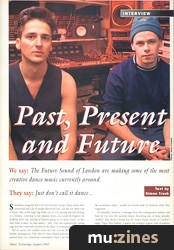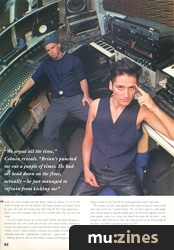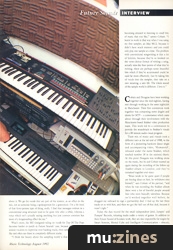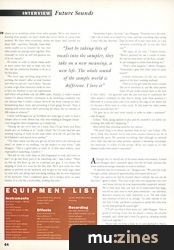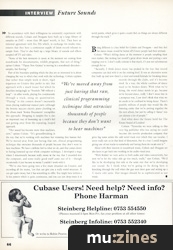Magazine Archive
Home -> Magazines -> Issues -> Articles in this issue -> View
Past, Present and Future | |
Future Sound of LondonArticle from Music Technology, August 1992 | |
London Calling
We say: The Future Sound of London are making some of the most creative dance music currently around. They say: Just don't call it dance...

Image credit: James Cumpsty
Somewhere along the line it all went horribly wrong. Dance music went commercial and a lot of people discovered that, just like any other type of music, they could make big bucks out of it by playing safe and sticking to a formula. Listening to the national charts, you could be forgiven for thinking there was nothing of interest going on in dance music (or any other kind of music for that matter - Ed); that the experimental cutting edge had been terminally blunted by the allure of commercial success.
But of course, the coalface work can only ever be done in its natural habitat: underground. Only after it's been filtered and sieved and generally watered down for commercial consumption does it see the light of day in the mainstream charts - usually on records made by imitators rather than originators.
Occasionally, however, a message from the underground surfaces and finds its way into the national charts, becoming one of those periodic 'unlikely' hits. Such a record was the recent Future Sound of London's single 'Papua New Guinea', a spacey and strangely organic wash of ambient atmospherics, haunting wordless vocals, shuffling dance beats and almost subliminal dubwise bass which reached the number 22 chart slot.
Following its success, came The Future Sound of London's debut album Accelerator, a diverse and equally experimental melange of instrumental tracks that went straight into the album charts at number 75 on its first week of release. So who the hell are The Future Sound of London? You'd be none the wiser for having seen their Top Of The Pops appearance - unless you really thought that the two vocalists had come up with the music.
The real Future Sound are in fact Gary Cobain and Brian Dougans, a production duo who work out of their own small studio, Earthbeat, situated incongruously in a quiet, leafy north London suburb as part of an 'artistic enclave' which includes a second, even smaller recording studio, a rehearsal studio and - significantly, it turns out - a pool room.
Settling down to chat in their studio, Cobain and Dougans explain that using vocalists for the Top Of The Pops appearance wasn't their idea.
"We couldn't use the vocal samples in the track, because all vocals on the show have to be live," recalls Cobain. "So, we had to get in a male singer and a female singer to sing the sample parts, but then the engineer saw two front people, took it as a band and mixed the vocals far too loud - even though we asked him not to. Also, the cameras were on the front people all the time - we didn't even get our faces on TV!"
Using singers to provide a visual focus is one thing, but making them the aural focus as well represents a misconception of what Cobain and Dougans set out to achieve in their music.
"The way we work, our vocal parts are in the backing rather than soaring above it. We go for vocals that are part of the texture, as an effect in the mix, not as someone being a spokesperson for a generation. I'm a bit tired of that front-person type of thing, really. I find that messages written in a conventional song structure tend to be quite trite after a while, whereas a voice which isn't actually saying anything but just conveys emotion has more of a longstanding effect for me."
What's more, the MU-instigated ruling on vocals for Top Of The Pops becomes harder to justify in Future Sounds' case, because they often pay session vocalists to improvise over backing tracks, then sample the bits they like and often use them in completely different tracks.
"I think the beauty about the sampling world is that you're basically becoming attuned to listening to small bits of music that you like," opines Cobain. "I learnt to work in that way when I was using my first sampler, an Akai S612, because it didn't have much memory and you could only play one sample at a time. The problem with conventional songwriting is that a lot of lyricists, because they're so hooked on the verse-chorus format of writing a song, actually miss the finer points of what they're writing, there are perhaps some beautiful bits which if they're accentuated could be used far more effectively. Just by taking bits of vocals into the sampler, they take on a new meaning, a new life. The whole sound of the sample world is different. I love it."
Cobain and Dougans have been working together since the mid-eighties, having met through working in the same nightclub in Manchester. Their first commercial work together was composing some jingles and idents for MTV - a commission which came about through their involvement with the Manchester-based Stakker video production team. This work led to a commission to provide the soundtrack to Stakker's visuals for a 30-minute audio-visual program.
Their mix of music and visuals took a different turn at the tail end of 1988, in the form of a pioneering hardcore dance single and accompanying video, 'Humanoid', released under the name Stakker, which reached number 18 in the national charts. At this point Dougans was working alone on the music, but he and Cobain teamed up again during the recording of the follow-up Stakker album in London, and they've remained together ever since.
"We argue all the time," Cobain reveals. "Brian's punched me out a couple of times. He had my head down on the floor, actually - he just managed to refrain from kicking me"
"Brian tends to be quite quiet if people are forcing ideas on him, he withdraws into himself," says Cobain of his partner, "and when he was recording the Stakker album there were a lot of forceful people around him who were basically talentless. Because we'd worked together well before, he dragged me onboard to sign a partnership deal. I tied up the last three tracks or so with him, and then we got the hell out of that deal, because it wasn't right."
Today the duo record for the small independent label, Jumpin' and Pumpin' Records, releasing tracks under a variety of guises. In addition to their Future Sound of London work, they are also responsible for singles by Smart Systems, Mental Cube and Intelligent Communication - obscure, but essential to their experimental way of working.
Cobain: "It's kind of like we're two guys here, it's really not that interesting, but with these different names we can pretend there's a bit of a scene down here! But also, the fact that we work under different names allows us to assimilate styles from other people. We're not closed to learning from people, we don't think that we're better or worse than anybody. We learn from everybody, within the dance field, outside the dance field - anywhere. Basically, those other names enable us to research the way that other people are putting tracks together. Then eventually we come up with this glorious mix of all our research."
Of course, in order to release tracks under so many names they had to make sure that they had the contractual freedom to do so in the first place.
"We never sign anything long-term, or anything that doesn't allow us total freedom over what we put out," says Cobain, "because in order to get these innovative tracks we have to have the freedom to put out experimental stuff which will probably only sell 3000 copies. Actually, in today's musical context it's almost bizarrely commercial to do something completely way out, because then it stands a chance above all the muck coming out that's formularising dance music and preventing it from going forward. There is amazing stuff within dance that's advancing the music, but it's released on 500 copies or whatever."
Cobain and Dougans set up Earthbeat two years ago in order to have a 'proper' place to work. Before that, they were working at Dougans' house - a not altogether ideal arrangement, as it turned out.
"During the day we'd start on a track, then I'd go home and Brian would carry on working on it," recalls Cobain."So I'd come back the next morning wanting to work on the track where we'd left off, and find that he'd finished it and moved on to another!"
"The other reason was that you get out of your bed in the morning and there's no desire to do anything, 'cos the studio's in your house," adds Dougans. "This is a good place to travel to. It feels more realistic, more responsible or something. I prefer it."
"But still we only work when we feel invigorated to work, and when we don't we go and shoot pool or do something else," adds Cobain. "When we first set this place up and we combined our gear, it was almost like stripping in front of a lover for the first time. We'd each invite the other person to perform on the keyboard, and we got to this awful stage where we were both just sitting back and doing nothing, like we were frightened of the keyboard. That's completely gone, we've broken down so many barriers. It is a bit like a relationship, working this close."
"Sometimes it gets a bit tense," says Dougans. "Yesterday was a bit tense. I did a bit of work on an Inner City remix, and Gaz was sitting there saying 'I don't like this direction.' Then he went off to play some pool, so I just switched everything off. It was like 'fuck you!'"
"We argue all the time," Cobain reveals. "Brian's punched me out a couple of times. He had my head down on the floor, actually - he just managed to refrain from kicking me!"
"That's what happens," admits Dougans. "Sometimes it goes well, other times it's quite heated!"
"Just by taking bits of vocals into the sampler, they take on a new meaning, a new life. The whole sound of the sample world is different. I love it"
Cobain elaborates on the less violent aspects of the duo's working methods:
"One of us has got some key source sounds that we're interested in, and the other person backs off and works around them to the best of their ability - but generally takes the piss and tries to undermine the other person's confidence in what they're doing, make them question it. Obviously at a certain point each of us comes to the edge of our ability and it's become a Brian track or a Gary track. At that point the other person comes in and adds their bit."
"Or goes up to the pool room instead in order to make a statement!" adds Dougans.
Cobain: "Yeah, going upstairs to play pool by yourself is our subtle way of saying 'this really isn't happening.'"
More subtle than punching someone out, anyway...
"The good thing is we always question what we do," says Cobain. "We don't think that because we've had some success whatever we do is automatically great. We question everything. And although we pretend every other day that the other person's opinion is becoming increasingly less important, in reality it's the reverse. We're very tuned in, it's like Siamese heads where music's concerned."

Image credit: James Cumpsty
Although they've moved out of the home studio environment, Cobain and Dougans don't necessarily agree with the oft-made criticism that home studios encourage musicians to work in isolation.
"It depends what level someone's at," Dougans says. "We each had to go through a certain amount of apprenticeship with sound and so on."
"Yeah, you need to do that by yourself, there's nobody else you can do that with," agrees Cobain. "You have to get your own equipment into your own house and just do your apprenticeship completely isolated. We've both done that, and now we've transcended that stage, but still we each need to work alone sometimes - our individual discovery sessions are really important to us. The best tracks have elements of both of us, though. I'm fairly melodic in the way that I work, and Brian is prepared to spend that extra time on the desk getting the sound right."
"I'll tell you what it boils down to," adds Dougans. "Gaz is good at writing tunes but he doesn't choose his sounds properly, and I think that's what I'm good at, choosing sounds that work together."
"Every time we write a track we try and approach it from a new angle, like we use different drum sounds," says Cobain. "There's a beauty in using the same drum kit and researching it thoroughly, but for me I prefer to use different sounds every time I write a track, try to push the boundaries of what we do."
In accordance with their willingness to constantly experiment with different sounds, Cobain and Dougans have built up a large library of samples on DAT - more than 30 tapes' worth, in fact. They have an informal agreement with five DJs which, in exchange for studio time, ensures that they have a continuous supply of latest record releases to sample from. They've also built up a large library of sounds and effects sampled off TV and video.
"We've moved away from just having that raw, clinical programming technique that ostracises thousands of people because they don't want to hear machines"
"Some of the best moments in music at the moment are coming from soundtracks for documentaries, wildlife programs, that sort of thing," opines Cobain. "'Papua New Guinea' is moving in a soundtrack direction - samples, but flowing."
Part of the boundary-pushing which the duo are so interested in is about changing the way in which they work with the technology. Cobain explains that rather than simply work in short, rigid sequences on Creator they prefer to mix that approach with a much looser feel which he describes intriguingly as "freestyle 768 without a loop" - in other words, playing live continuously through a track, using no quantisation.
"Playing" in this context doesn't necessarily mean playing traditional musical parts (although the frenetic staccato electric piano chording on the album track 'Stolen Documents' exemplifies this approach). Dropping in samples live is also an important way of loosening up a track's feel and getting away from the repeating, looped approach.
"Our sound has become more than machines, now," opines Cobain. "It's groundbreaking in the way that we're working with machines but retaining that human feel. We've moved away from just having that raw, clinical programming technique that ostracises thousands of people because they don't want to hear machines. We have a definite feel to what we do, and that comes down to having loosened up our whole computer technique. I developed a stage where I intentionally became really messy in the way that I recorded into the computer, and some really good stuff came out of it - though occasionally it just became so messy I couldn't work with it.
"We've also been going into a live mute situation on Creator, and recording all the mutes, 'cos that can give you a really weird structure. It can get quite messy, but it has something to offer. You might have written a hi-hat pattern which is quite continuous, and you can just drop-mute it at weird points, which gives it quite a scatty' feel, so things are always different through the track."
Being different is a key belief for Cobain and Dougans - and they feel the dance music would be better off if more people had their attitude.
Cobain: "What's killing dance at the moment is people sampling their own market, like nicking last month's great drum break and putting a new topping over it. I don't really criticise it that much, it's just not adventurous enough for us.
EQUIPMENT LIST
- Akai S612 Sampler + MD280 Disk Drive
- Akai S900 Sampler
- Akai S1000 Sampler w/8Mb memory
- E-mu Proteus/1 w/Protologic board
- Jen SX1000 Synth
- Roland D110 Synth Module
- Roland JX3P Synth
- Roland MC202 Monosynth
- Roland MKS50 Synth Module + PG300 Programmer
- Roland TB303 Bass Synth
- Roland TR606 Drum Machine
- Yamaha DS55 Synth
- Yamaha TX81Z
Effects
- Alesis Quadraverb (x2)
- Alesis MIDIverb II
- BBE 422A Sonic Maximiser
- Bel Electronics BD80 Digital Delay
- Drawmer DS201 Dual Gate
- Fostex 3070 Compressor/Limiter
- Ibanez DM1100 Digital Delay
- Korg DRV1000 Digital Reverb
- Yamaha SPX90 Multi effects Processor
Recording
- Aiwa HDX1 DAT Recorder
- Atari 1040ST Computer w/C-lab Creator software
- Fostex B16 Multitrack
- Groove MC2V MIDI/CV Converter
- Korg KMS30 Sync Unit
- Nakamichi 480Z Cassette Deck
- Sony DTC1000ES DAT Recorder
- Soundtracs CM4400 Mixing Desk
- Technics SL1200 Mk2 Turntable
- Yamaha NS10M Monitors
"Actually, I think dance music has peaked in the way that record companies can deal with it on the existing level. It was an alternative scene that built up and now there's a tried and tested formula for breaking dance records through the clubs, and it's become tired. In a way, the whole confines of dance need to be broken down. With what we're doing, the word dance needs to go, because we're beyond dance, really. I don't mean that in a pompous way, I just don't think that what we do needs to be confined to being dance. There's possibly millions of people that would like the listening entity that we're putting together for the next album, but just by calling it 'dance' you can alienate a lot of people."
And what does the future hold for The Future Sound of London?
Cobain: "Yesterday we were talking to this very big publisher who was saying we could become this novelty production company that gives big name artists the odd weird track over which they can vocalise. I never really saw us in that kind of dimension, but in a way I could imagine giving one of our tracks to somebody and having them do vocals over it."
Allied with their interest in soundtrack music, Cobain and Dougans are also keen to get back into working in the audio-visual area.
"With Stakker we were active in both audio and video concurrently, but now we've let the video side go too much, really," says Cobain. "We'd like to be developing that side at the same rate that we're developing our sound. So I think what we're going to be doing here is knocking through the wall when the guy next door goes and setting up a U-matic edit suite. Our images should be as sophisticated as our music.
More with this artist
Publisher: Music Technology - Music Maker Publications (UK), Future Publishing.
The current copyright owner/s of this content may differ from the originally published copyright notice.
More details on copyright ownership...
Interview by Simon Trask
Previous article in this issue:
Next article in this issue:
Help Support The Things You Love
mu:zines is the result of thousands of hours of effort, and will require many thousands more going forward to reach our goals of getting all this content online.
If you value this resource, you can support this project - it really helps!
Donations for January 2026
Issues donated this month: 0
New issues that have been donated or scanned for us this month.
Funds donated this month: £0.00
All donations and support are gratefully appreciated - thank you.
Magazines Needed - Can You Help?
Do you have any of these magazine issues?
If so, and you can donate, lend or scan them to help complete our archive, please get in touch via the Contribute page - thanks!
